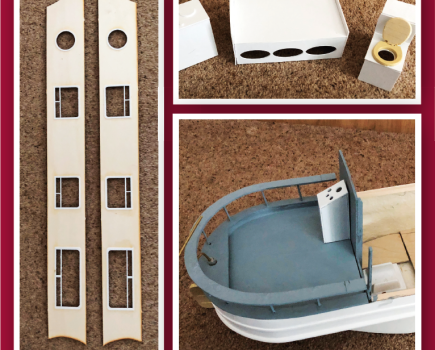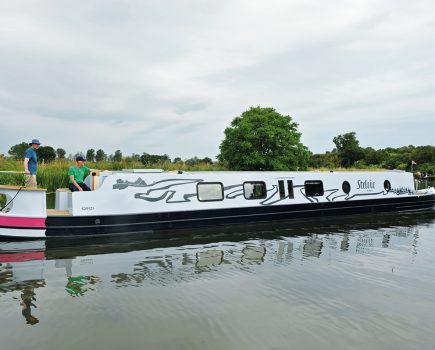Finding a boat in their price range seemed an impossible task and the one they found would give even a ‘doer-upper’ a bad name, but they persevered…

Words: Lizzie Faircliff; Pictures: Lizzie Faircliff and Chris Addison
One autumn, many moons ago, two young couples embarked upon the adventure of a lifetime. After many small trips on hire boats, the four decided the time had come for them to buy their own. They were ready, but their price range was a little small, to say the least.

Armed with nothing but their looks and charm, they found naught. The boating aristocracy appeared to sneer down on them and even the fixer-uppers smirked at their meagre savings. Then, after arduous weeks traipsing around boatyards, the fates turned.
It was by chance that Paul – the tallest and least charming of the lot – stumbled upon the advert. The golden light shone down upon a picture of a rather rundown, semi-drowned boat up for sale.

A survey showed this was exactly the sort of boat you would find stewing in its own filth on the outskirts of a city, drinking up the canal. However, the inches of water obscuring the floor, the floating mouldy bed and the sofa crawling with more life than anything found outside the boat did not deter the two couples, and they bought it. There was a long road ahead.
As destiny would have it, this was no ordinary garden variety boat. It was Miranda, the first purpose-built hire boat by Wyvern Shipping. The four knew they had bought a pedigree boat made of good quality steel, as the surveyor noted, treated with an epoxy-based red oxide that had preserved the hull very well. Originally it had a wooden top but this had since been replaced with steel. It was a boat like no other.

After years of hauling around holiday-makers, Miranda had been retired. She was looking forward to years of knitting and drinking tea, but alas was burned out in Coventry basin. According to legend, she was bought by a farmer but left to vegetate and rot in a field for some years under the name Saville Row.
She withered and crumbled, until that fateful day when she passed into the hands of Paul, Juliet, Hugh and Bernadette – the two young couples. And so the boat was revived, and given the great name of Dvbris.

The first step was to get rid of the sofa. Then they reached out to more experienced, skilled help to install a water tank and a new tiller. Prioritising jobs, they got the alternator, gas and water heater up and ready to go. With a Lister SR2 engine and a somewhat undersized propeller (which required several days’ notice to stop the boat), emergency stops were not its strong point.
While cleaning under the floor, Hugh – the tough Welsh one – pulled the seacock out, leaving a one and a half inch hole in the floor. This was considered to be a problem. He stuck his foot in the hole while the team drove the boat as fast as its undersized propeller would carry them to a very obliging boatyard, where the hole was fixed. It was mishaps such as these that explain why the fixing up of the boat took more than 20 years.

As their families bloomed, the number of voyagers increased to nine. It was, Hugh thought grumpily, a bit cramped so it was time for an upgrade. The operation involved splitting the boat in two and whacking a new chunk in the middle. The boat ended up all original with a new top, new bottom, new fit-out and a new engine. Dvbris was now 68ft and roaring to go.
The years passed and the time came for the two families to go their separate ways. Paul and Juliet had been saving for a Hudson built boat of their own. They were in luck, one of Hudson’s customers had just dropped out and they nabbed his spot. Thunderfield was on its way to being born.

The first few months of building Thunderfield went smoothly. It was in the winter of 2014 that progress slowed. The unfortunate and unexpected passing of Steve Hudson closed Glascote basin and halted any boat building.
By February 2015, however, things were looking up. Paul and Juliet sought the help of other boat builders and finally found Stoke Boats at Longport Wharf to be the chosen builders to finish Thunderfield in the original style. Later that month, Thunderfield travelled not by canal but by land on the back of a lorry to Stoke and the building began again.

One October Thursday, Thunderfield graced the murky waters of the canal. From there it travelled back to Glascote Basin to be painted the dazzling yet traditional cream, green and red colours by Norton Canes. The two boats, one old and one new, were both setting out on another adventure.
Dvbris had gone from being a barely floating shell to a warm loving home for nine. Hugh now envisions a new fit-out to make it a nice boat for their family. Meanwhile, Thunderfield is go!
Thank you Lizzie for sending in your story.
Now it’s your turn to tell us about the boats in your life. If you would like to be featured in Me & My Boats in a future issue of Canal Boat magazine, send your story (about 1,000 words) and photographs (don’t worry, we’ll return them!) to editor@canalboat.co.uk. If it’s used, you’ll win £100!
____________________
More Me & My Boats:
Fiona Sims’ adventure to get her new boat to the marina
Martin and Margaret Eades set their sights on Boston
Neil Barnett fulfils a dream – reaching York by boat
Deborah Mendel-Lion stops hiring and starts buying
Image(s) provided by:
Archant







